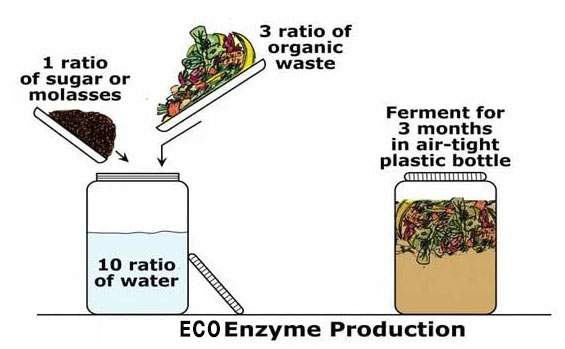
Eco-Enzyme how to Make
Below are simple instructions to make your own enzyme detergent. Although you can use any type of organic waste, I would recommend using fruit skins and/or vegetable wastes.
Ingredients:
10 liters – tap water
1kg – brown sugar
3kg – fruit skins (e.g. orange, lemon, papaya, apple, watermelon, etc) and/or vegetable waste
Halve the above for a 10 ltr container
Preparation Method:
1. Get yourself an empty and clean 20-liter plastic container with an airtight lid.
2. Fill the container with 10 liters of tap water.
3. Add 1 kg of brown sugar or any kind of unprocessed sugar and stir until it dissolves in the water. DO NOT use the normal processed white sugar.
4. Add 3 kg of fruit waste into container. It might take some time to collect such amount of fruit waste – get them from fruit stalls keep it in a zip bag in the freezer until you have enough you don”t have to thaw it before use.
5. Mixed the ingredients properly in the container with a clean plastic ruler or stick
6. Close the lid of the container tightly.
7. During the first month of fermentation, open the lid once every two days and stir the mixture. This is to release gas produced during fermentation and at the same time allow more oxygen for the fermentation.
8. Leave the mixture for another two months (in sheltered location) to allow fermentation to continue. During this period, stir the mixture once every two weeks.
9. After three months, the enzyme should have a dark-brown colour is ready to be used. Remove the all fruit skins and remainder (use them as fertiliser for your plants).
10. You may want to bottled them to smaller handy bottles.
Helpfull advice:
Plastic container is preferred as gas will be released during the fermentation process. Plastic containers is not as rigid as glass or metal.
Do not use fruit/vegetable wastes that are rotten or have fungus on them.
During the fermentation process, it will produce some smell. Make sure you close the lid of the container tightly.
To know if fermentation process is going well, you should see a white layer of bio-film on the surface of the enzyme.
If you want to make a smaller quantity, reduce the ratio accordingly – i.e. 10 parts of water, 1 part of brown sugar and 3 parts fruit/vegetable wastes.
The above Eco-Enzyme formula is concentrated. You need to dilute it with water before using. Since different usage requires different concentration, start with one capful of enzyme to one liter of water and reduce/add as needed. Don’t be too worried about getting the right concentration.
There are many uses of Eco-Enzyme. Their antibacterial and antiviral resistance properties make them great for cleaning drains, floors, bathrooms, dishes, fruits, vegetables, and even your body. Eco-Enzyme improves air quality by removing foul odours and drives away insects in your home. Besides being an effective cleaning agent, Eco-Enzyme is biodegradable, which helps protect our environment as compared to using conventional chemically produced detergents
DILUTION RATE # USAGE # QUANTITY # APPLICATION
Bath (add in bath water to improves skin condition) # 50~100cc # Keep overnight
Washing machine (clean and soften laundry) # 20-50cc # Soak and wash
Concentrated # Toilet bowl (prevent blockage & purify sewage) # 250cc # Pour and flush
Enzyme # Toilet cistern (purify water) # 20-50cc (two caps) # 2-3 times/ weeks
Garden pond & water tank (purify water) # 1/10,000 litre water # Add occasionally
Leather sofa (clean mold or stain) # Appropriate amount # Spray and wipe every 10 days
Carpet & tatami mat (deodorize & antiseptic) # Slightly moist # Spray 1-2 times/month
Shoe, inside the car (deodorize & antiseptic) # Appropriate amount # Spray occasionally
10-50 times # Kitchen sink, stove, cooker hood (clean oily stain)
Appropriate amount # Soak and wipe occasionally#
Black mold (antifungal) # Appropriate amount # Soak and wipe occasionally
Pet excretion, pet house (deodorize & antiseptic) # Appropriate amount # Spray occasionally
200-500 times # Air-conditioned room (humidifier, deodorize &
antiseptic) # Appropriate amount # Spray occasionally
Bathroom sink (clean) # Appropriate amount # Soak and wipe occasionally
Cabinet and refrigerator (deodorize) # Appropriate amount # Spray occasionally
500 times # Drain (prevent drainpipe blockage) # Appropriate amount Flush occasionally
Pet (bathing, deodorize & antiseptic) # Appropriate amount # Upon bathing or brushing
Toilet (clean, deodorize & antiseptic) # Appropriate amount # Spray when wiping
500 – 1000 times # Indoor (purify air, deodorize & pest control) # Appropriate amount # Spray frequently
Closet, clothes (deodorize & antiseptic) # Slightly moist # Spray occasionally
1000 times # Seeding and planting (fertilizer) # Appropriate amount # Rinse once
FOR GARDENING OR FARMING:
Dilute to 1000 times with water for use as natural insecticides, herbicides, pesticides and organic fertilizers. Also can be used to stimulate plant hormone to improve quality of fruits and vegetables and to increase crop yield.
Spray on idle land for 3 months continuously to improve soil quality.
In agriculture, garbage enzyme is used:
– to reduce the usage of chemical fertilizers
– to keep the farm free from insects and infections
– as a soil fertilizer for vegetable growing
– as a natural pesticide and herbicide
– to convert sandy land to fertile farm land
– keep the air cool and clean in the farm atmosphere
– clean the dirty and impure water in the farm
